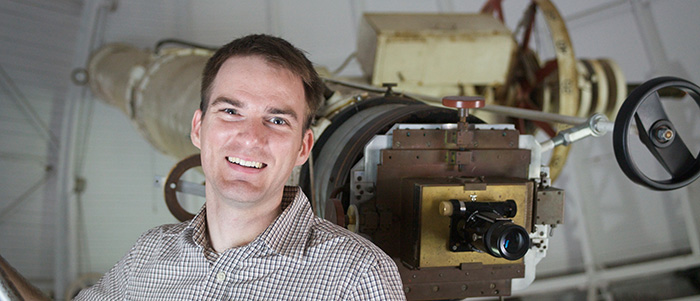Conditions Around the Sun 5 Million Years Ago Now Known, Wesleyan Study Says


Using high-resolution data obtained from the Space Telescope Imaging Spectrograph aboard the Hubble Space Telescope, Wesleyan University Professor of Astronomy Seth Redfield can show the conditions the Sun encountered traveling through space over the past 5 million years.
Redfield will present his findings Jan. 12, 2022 as part of a press conference associated with the American Astronomical Society’s previously planned annual conference. This work was a close collaboration of Redfield with Hunter Vannier ’20, and a major component of Vannier’s senior thesis. Vannier is now a PhD student at Purdue University working on lunar mineralogy.
By focusing on eight paths, each of which is within 200 light years along the Sun’s historical trajectory, Redfield and his lead-author Vannier can reconstruct the composition of the Earth’s most recent interstellar environment and evaluate its effects on the Sun’s heliosphere (the protective magnetic field surrounding our solar system).
“When you look at the night sky it looks kind of the same as it did yesterday, so we have a sense that the universe is static,” Redfield said. “But it is dynamic and changing. Some things change on short-term scales that we are used to – stars can have a flare or the planets can align or there can be a solar eclipse. But the Earth and the Sun have been around for four and a half billion years. So, we need to conceptualize changes around that time scale.”
Redfield’s research focuses on the local interstellar medium (LISM), which is the gas and dust that exists between the stars. The most common example of particles in space interacting with a magnetic field can be seen in the spectral, shimmering light of the Aurora Borealis. The heliosphere provides a similarly protective shield for us at the edge of our solar system.
The local interstellar medium is a complex environment, comprised of a suite of interstellar clouds extending 50 light years and surrounding the nearest stars. The Sun entered the local interstellar cloud, the material that currently surrounds the solar system, approximately 64,000 years ago, and is expected to exit this cloud within a few thousand years.
“Our Sun, indeed all stars, expel particles that push against their surrounding interstellar medium and create a protective bubble, called the heliosphere. As our solar system journeyed through our galaxy, the Milky Way, the Sun’s heliosphere may have been significantly compressed by a dense cloud of gas and dust,” Redfield said.
The properties of the local interstellar medium are important in understanding the interaction between the Sun and other stars with their surrounding interstellar environments, Redfield said. The variability in the LISM over millions of years may have had an impact on the energy and quantity of particles raining down on the Earth and influenced the cloud cover and biological mutation rates.
Redfield’s findings give a sense of the conditions in the universe that might contribute to the conditions on planets and may even influence the evolution of complex life. “For example, we know that there is a large variation in the effectiveness of organisms DNA repair mechanisms. Simple life is overly capable of DNA repair, and therefore can exist in a wide range of seemingly hostile environments, while complex life, like humans, are just able to repair DNA damage in our current environment. I am excited to pass along these results to my astrobiological colleagues and explore the implications that a changing radiation environment could have on the evolution of life,” Redfield said.
Using the information gleaned from our own solar system, Redfield can start to evaluate the protective interface present around other stars and planetary systems. Not only is Redfield and Vannier’s research applicable to the heliosphere in the past, the same technique can be used to extrapolate what might happen to the heliosphere millions of years in the future.
“This isn’t just about the Earth. This is something that is happening everywhere,” Redfield said. “For the past, I can tell you what the Sun went through. We can do this for the future as well.”
For more information about Redfield’s work, visit his website.
The project was supported by NASA HST Grant GO-14084 awarded by the Space Telescope Science Institute, which is operated by the Association of Universities for Research in Astronomy, Inc., for NASA, under contract NAS 5-26555, and funding through undergraduate research fellowship from the Connecticut Space Grant Consortium.
Media contact:
Steve Scarpa
Manager of Media and Public Relations
sscarpa@wesleyan.edu

